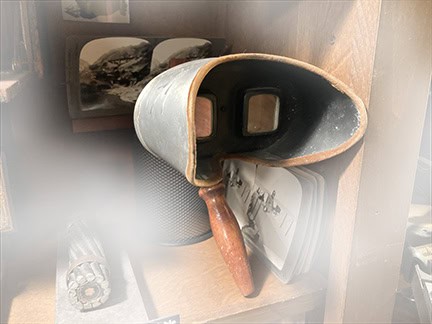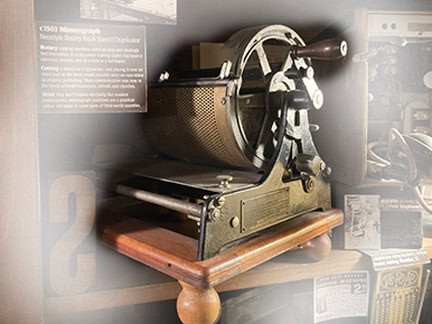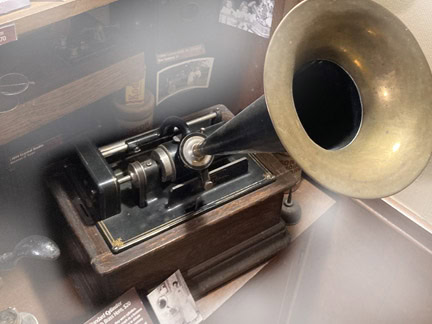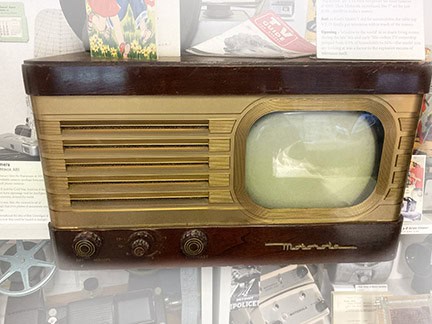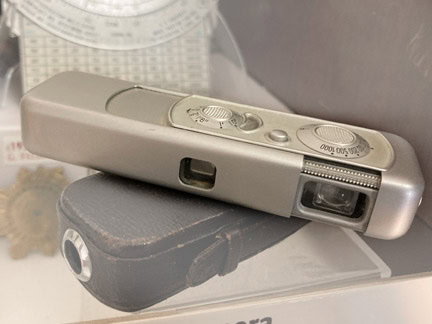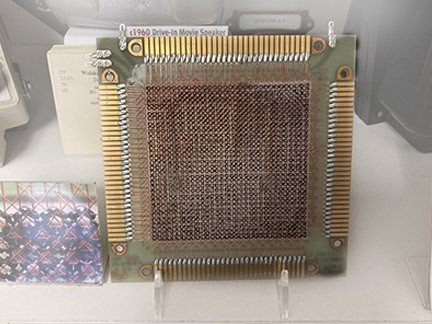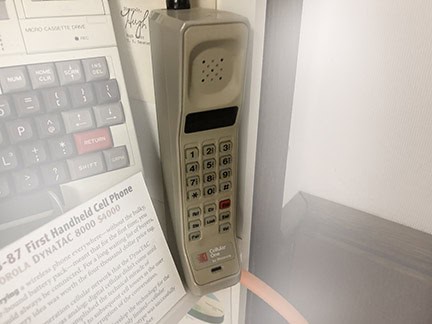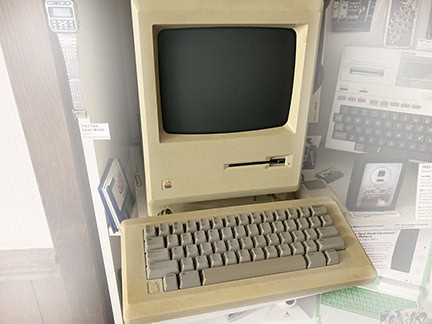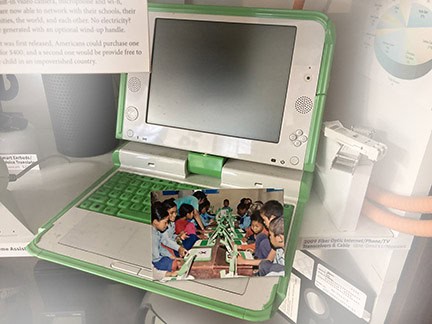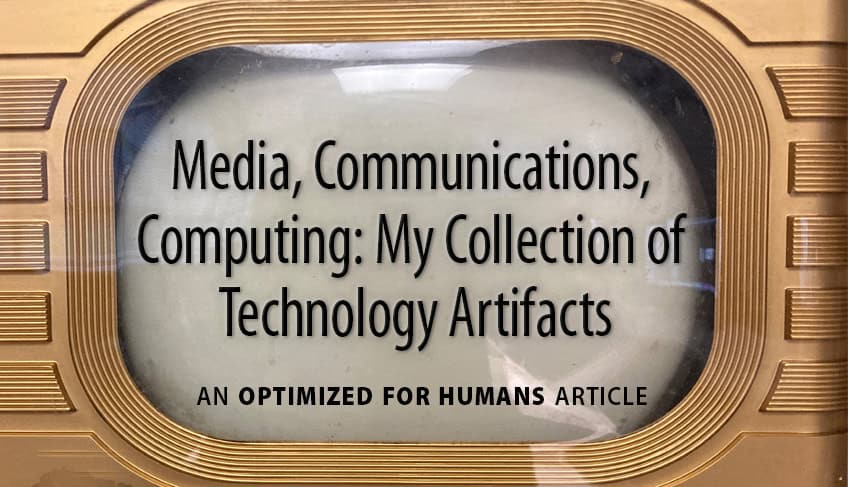
B Y T O M T O R T O R I C I
There’s all kinds of technology, from aerospace technology to refrigeration technology, and so much more. But in the foreground of our lives day to day, there’s media, communication and computing technology. My physical collection of almost 300 devices, accessories and media samples – from the mid-1800s to modern times – chronicle the evolution of that world-changing trinity.
Below are a few of those items, along with some of the fascinating bits of history I’ve learned about them. To check out the entire Technology Artifacts collection, just click over to:
https://market-media.net/extras/museum.pdf
______________________
1901 Stereoscope
UNDERWOOD & UNDERWOOD SUN SCULPTURE
In a time before newspapers had photographs, these popular 3-D viewers offered a window on the world. They exposed people for the first time to foreign travelogues, how-it’s-made factory scenes, and even dramatic and comedic series. In other words, many of the things we watch on TV today.
The ‘stereoview’ photographs were taken with special dual-lens cameras. These recorded two views, 2.5 inches apart—the same as the distance between our two eyes.
Where technology goes, smut isn’t far behind. Soon stereoviews were available with au naturale models, often frolicking in nature settings, in 3-D no less.
______________________
1903 Mimeograph
NEOSTYLE ROTARY NO. 6 STENCIL DUPLICATOR
Rotary copying machines were an easy and blazingly fast innovation. Up until then, making copies had been a laborious process, one at a time in a flat frame.
Cutting a stencil on a typewriter, and placing it over an inked pad on the drum, made possible what we now know as desktop publishing. Mass communication was now in the hands of small businesses, organizations, schools and churches.
Since they don’t require electricity like modern photocopiers, mimeograph machines are a practical option still today in some parts of third-world countries.
______________________
1905 Cylinder Phonograph
EDISON STANDARD $20
The first records weren’t flat discs–they were cylinders. Edison originally conceived of the phonograph as a business machine; original models allowed an executive to dictate and record letters, to later be transcribed by his secretary.
Musicians found that they could use the device to record and play back their practice sessions, enabling them to spot mistakes. Soon, music lovers began offering to buy these practice recordings for listening at home, thereby establishing the American recorded music industry.
At first, people back then listened to popular tunes, and vaudeville comedy, without the need for electricity. The motor for spinning the cylinder was a wound-up spring, and the sound was effectively amplified by a simple horn.
______________________
1947 Television
MOTOROLA GOLDEN VIEW VT-71 $190
The year that full-scale commercial broadcasting began, ‘big screen’ 10-inch TVs were too pricey for most families at $350. Then Motorola introduced this 7-inch set for just $190 — $1600 in today’s money.
Just as Ford’s Model T did for automobiles, the table-top VT-71 finally put television within reach of the masses.
Opening a ‘window to the world’ in so many living rooms during the late ’40s and early ’50s — when TV ownership jumped from 0.5% of households to 56% — this model was a factor in the explosive success of television itself.
______________________
1954 Spy Camera
MINOX GMBH MINOX AIII
It was released as a luxury item for Europeans in 1937: a palm-size, always-available camera — perhaps forecasting today’s digital and cell phone cameras.
During World War II and the Cold War, however, it became the prestigious, must-have espionage tool for intelligence agencies, and their enemies, around the world.
Even with its tiny 9.2 mm film, the camera’s level of precision was so high that even photos of documents would come out razor sharp.
Since the Minox introduced the idea of film ‘cartridges,’ it was the first camera ever that could be loaded in daylight.
______________________
1958 Mainframe Computer Core Memory Plane
UNIVAC II $2000
From the days when a computer filled an entire room, this core memory was the first solid-state computer memory, and the last time you could actually ‘see’ memory.
Look closely. Each of those 4000 tiny round metal ‘cores’ represented one bit or byte of information. These planes came in sets of five, for a whopping 20k of memory, at a cost of $10,000.
The cores are woven together with the slender wires that gave them their positive or negative charge. The only people capable of such an exacting effort were skilled female textile workers, who suddenly found themselves in the computer business
______________________
1983 First Handheld Cell Phone
MOTOROLA DYNATAC 8000 $4000
Carrying a wireless phone everywhere — without the bulky battery pack of a ‘car phone’ —meant that for the first time, you would always be connected. For a long waiting list of buyers, that very idea was worth the four-thousand dollar price tag.
The first generation cellular network that the DynaTAC connected to was analog, and seriously limited; digital cellular didn’t come until 2G. But it still accomplished the technical miracle of ‘handing off’ a signal to subsequent cell towers as the user drove along, with no interruption of the conversation.
It took Motorola ten years to develop the technology for this pioneering phone and network. The first call on an early prototype was successfully connected, but reportedly to a wrong number.
______________________
1984 First ‘Graphical User Interface’ Computer
APPLE MACINTOSH $2500
Other computers at the time displayed only green text and programming code against a black background. The Mac permanently revolutionized, and humanized, the computer experience with a ‘desktop,’ windows, menus, icons, folders and a mouse. Microsoft’s imitation of the Mac’s interface, known as Windows, finally caught up six years later.
The first release of the Mac had lots of potential, but with just 128k of RAM and no internal hard drive, it had neither the power or the storage to actually accomplish anything useful.
Steve Jobs foresaw the future of personal computers by declaring the MacIntosh a communication device rather than a computing device. To help spark creative communication, Apple bundled the novel, friendly and intuitive MacWrite and MacDraw applications with every Mac.
______________________
2007 First Third-World Educational/Networking Platform
ONE LAPTOP PER CHILD XO-1
It was conceived and designed as an educational platform to bring children of developing nations into the twenty-first century. In addition to drawing, writing, news and music apps, a twist of the screen turned it into an e-book reader.
With a built-in video camera, microphone and wi-fi, children were now able to network with their schools, their communities, the world, and each other. No electricity? Power could be generated with an optional wind-up handle.
When it was first released, Americans could purchase one online for $400, and a second one would be provide free to a lucky child in an impoverished country.
______________________
People peering into their Stereoscopes at the dawn of the twentieth century couldn’t possibly imagine the home technologies yet to come. And even with the spectacularly advanced media, communications and computing devices in our own pockets and purses … neither can we.
Share It:
 About the Author: Tom Tortorici is an Atlanta copywriter and web content writer who helps companies make a genuine connection with their audience. His classes and conference presentations have focused on how writing, strategy and design can work together to grab attention and interest even among readers with short attention spans. In addition to working directly with businesses, Tom regularly partners with web designers and marketing agencies.
About the Author: Tom Tortorici is an Atlanta copywriter and web content writer who helps companies make a genuine connection with their audience. His classes and conference presentations have focused on how writing, strategy and design can work together to grab attention and interest even among readers with short attention spans. In addition to working directly with businesses, Tom regularly partners with web designers and marketing agencies.
All Posts/Subscribe >
Info for Businesses >
Info for Designers/Agencies >
Tom Tortorici Inc. | Tom@TomTortorici.com | 770-934-7861 | 3101 Rockaway Rd | Atlanta GA 30341

